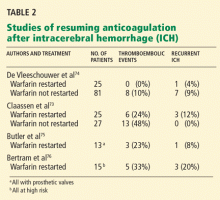Should anticoagulation be resumed after intracerebral hemorrhage?
ABSTRACTIntracerebral hemorrhage (ICH) is the most feared and the most deadly complication of oral anticoagulant therapy, eg, with warfarin (Coumadin). After such an event, clinicians wonder whether their patients should resume anticoagulant therapy. The authors review the management of anticoagulation during and after anticoagulation-associated ICH.
KEY POINTS
- Given the high risk of hematoma expansion in the early phase of acute ICH, most experts recommend reversing anticoagulation immediately.
- Many clinicians start subcutaneous heparinoids in low doses 24 to 72 hours after ICH to prevent deep vein thrombosis, and after the first few days or a week, consider either increasing the dose to a full anticoagulation dose or making a transition to oral anticoagulants.
- Many patients with lobar hemorrhage or cerebral amyloid angiopathy may remain at higher risk of anticoagulant-related ICH recurrence than thromboembolic events and would therefore be best managed without anticoagulants.
- Those with deep hemispheric ICH, hypertension that can be well controlled, and a high risk of disabling thromboembolism may receive net benefit from restarting anticoagulation.
Long-term risk of thromboembolism depends on underlying condition
In the long term, the risk of thromboembolism depends on the reason for which the patient was originally given anticoagulation. In addition, many patients with ICH suffer decreased mobility and are therefore at higher risk of venous thromboembolism than before their event.
Nonvalvular atrial fibrillation is the most common indication for anticoagulation. For these patients, the risk of ischemic stroke is 2% to 5% per year.66,67 The system usually used to stratify this risk is CHADS2, an acronym for five key risk factors:
- Congestive heart failure (1 point)
- Hypertension (1 point)
- Age over 75 (1 point)
- Diabetes mellitus (1 point)
- Prior stroke or transient ischemic attack (2 points).
The annual risk of stroke ranges from 1.9% (score of 0) to 18.2% (score of 6).68,69 In patients with nonvalvular atrial fibrillation, the excess risk of ischemic stroke without anticoagulation must be weighed against the risk of ICH recurrence.
A mechanical heart valve, another common indication, carries a risk of ischemic stroke of about 4% per year.70 A mechanical valve is traditionally considered an absolute indication for anticoagulation. However, patients with lobar ICH face a risk of recurrence that is greater than 4% per year, and so the risks of resuming anticoagulation may well outweigh the benefits.
Heart failure may be associated with a risk of ischemic stroke of 1% to 4% per year, and this is likely a function of disease severity.71
Venous thromboembolism. The risk of recurrent venous thromboembolism in patients with deep venous thrombosis or pulmonary embolism is around 4% per year.72 Given that ICH itself confers a 2% to 3% risk of these conditions, the rate of recurrence of deep venous thrombosis may well be much higher in those ICH patients who have also already had deep venous thrombosis.
Data on resuming oral anticoagulation after ICH
Notably, an analysis of 52 patients found a high risk of ICH recurrence (and gastrointestinal bleeding) in patients who restarted warfarin, and a high risk of myocardial infarction and ischemic stroke in those who did not restart, with neither strategy demonstrating a clear benefit in the rate of death or disability.73 All patients with a thromboembolic event were being treated for a previous event, suggesting that secondary prevention is a stronger indication for anticoagulation than primary prevention in this population.73
IF AND WHEN TO RESTART
Two major questions to consider are whether the benefits of restarting anticoagulation outweigh the risk, and if so, when and how should anticoagulation be restarted?
Whether to restart anticoagulation
As for the risk-benefit ratio, many think that anticoagulation should be restarted only with extreme caution and possibly only in those with deep ICH or a documented history of thromboembolism.19
In one decision analysis examining whether to restart anticoagulation after ICH in patients with atrial fibrillation, the risk of thromboembolism would need to exceed 7% per year to justify restarting anticoagulation after deep ICH,67 and no risk level was high enough to justify restarting anticoagulation after lobar ICH.
For patients at sufficiently high risk of ICH recurrence, antiplatelet treatment is probably safer, as antiplatelet agents carry a substantially lower risk of bleeding.54,77–79 The American Heart Association comments that for nonvalvular atrial fibrillation, long-term anticoagulation should be avoided after spontaneous lobar ICH, but that antiplatelet agents may be considered. 42 They note that anticoagulation after nonlobar ICH may be considered depending on the indication.42
The decision to restart anticoagulation may also be a function of whether the underlying risk factor is a temporary one. For example, atrial fibrillation or a mechanical heart valve confers a long-term, ongoing risk of arterial thromboembolism, and such patients would not normally be considered for a short course of warfarin therapy. However, isolated deep vein thrombosis may only require anticoagulation for a limited time, such as 3 to 6 months.80 Perhaps for such patients the long-term outcome is maximized with a narrowly defined, temporary course of anticoagulation.
When to restart anticoagulation
As for when to restart, it is not certain how long after symptom onset the risk of ongoing bleeding continues. Clearly, the risk is high on the first day, but small after the first few days.
The European Stroke Initiative recommends that patients with a strong indication for anticoagulation, such as a history of embolic stroke with atrial fibrillation, should be restarted on warfarin after 10 to 14 days, depending on the risk of thromboembolism and ICH recurrence.43
The American Heart Association suggests that, in patients with a very high risk of thromboembolism for whom restarting warfarin is considered, warfarin may be restarted 7 to 10 days after ICH onset.42
The American College of Chest Physicians recommends starting prophylactic-dose heparin the day after an ICH, with no clear guidance on restarting warfarin.81







